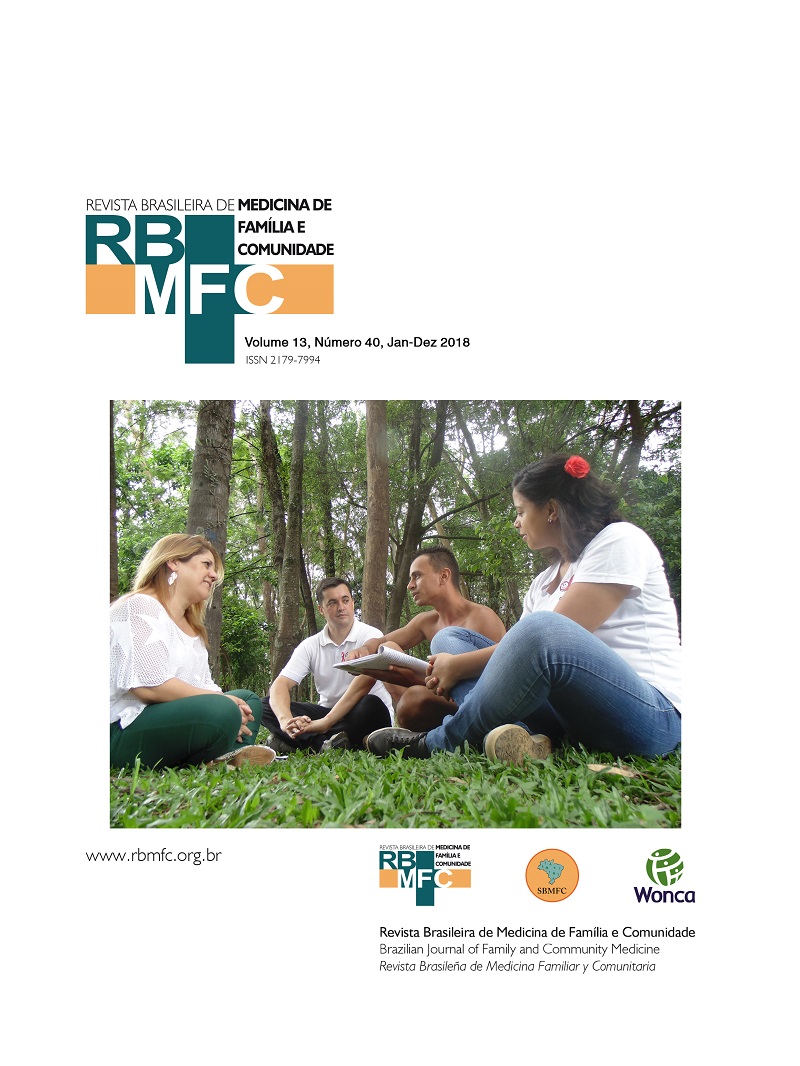Reliability and validity of ICPC-2-R encoding by medical students
DOI:
https://doi.org/10.5712/rbmfc13(40)1655Keywords:
Primary Health Care/classification, Observer Variation, Reproducibility of Results, Education, Medical, Undergraduate, Clinical ClerkshipAbstract
Objective: To estimate how reliably and validly can medical students encode reasons for encounter and diagnoses using the International Classification of Primary Care, revised 2nd edition (ICPC-2-R). Methods: For every encounter they supervised during an entire semester, three family and community physician teachers entered the reasons for encounter and diagnoses in free text into a form. Two of four medical students and one teacher encoded each reason for encounter or diagnosis using the ICPC-2-R. In the beginning of the study, two three-hour workshops were held, until the teachers were confident the students were ready for the encoding. After all the reasons for encounter and the diagnoses had been independently encoded, the seven encoders resolved the definitive codes by consensus. We defined reliability as agreement between students and validity as their agreement with the definitive codes, and used Gwet’s AC1 to estimate this agreement. Results: After exclusion of encounters encoded before the last workshop, the sample consisted of 149 consecutive encounters, comprising 262 reasons for encounter and 226 diagnoses. The encoding had moderate to substantial reliability (AC1, 0.805; 95% CI, 0.767–0.843) and substantial validity (AC1, 0.864; 95% CI, 0.833–0.891). Conclusion: Medical students can encode reasons for encounter and diagnoses with the ICPC-2-R if they are adequately trained.
Downloads
Metrics
References
Soler JK, Okkes I, Wood M, Lamberts H. The coming of age of ICPC: celebrating the 21st birthday of the International Classification of Primary Care. Fam Pract. 2008;25(4):312-7. https://doi.org/10.1093/fampra/cmn028 DOI: https://doi.org/10.1093/fampra/cmn028
World Organization of National Colleges, Academies, and Academic Associations of General Practitioners/Family Physicians. Classificação Internacional de Atenção Primária (CIAP 2). 2ª ed. Florianópolis: Sociedade Brasileira de Medicina de Família e Comunidade; 2009.
Lamberts H, Wood M, Hofmans-Okkes IM. International primary care classifications: the effect of fifteen years of evolution. Fam Pract. 1992;9(3):330-9. https://doi.org/10.1093/fampra/9.3.330 DOI: https://doi.org/10.1093/fampra/9.3.330
Britt H, Angelis M, Harris E. The reliability and validity of doctor-recorded morbidity data in active data collection systems. Scand J Prim Health Care. 1998;16(1):50-5. https://doi.org/10.1080/028134398750003412 DOI: https://doi.org/10.1080/028134398750003412
Letrilliart L, Guiguet M, Flahault A. Reliability of report coding of hospital referrals in primary care versus practice-based coding. Eur J Epidemiol. 2000;16(7):653-9. https://doi.org/10.1023/A:1007609718223 DOI: https://doi.org/10.1023/A:1007609718223
Sampaio MM, Coeli CM, Miranda NN, Faerstein E, Werneck GL, Chor D, et al. Interobserver reliability of the International Classification of Primary Care. Rev Saúde Pública. 2008;42(3):536-41. https://doi.org/10.1590/S0034-89102008005000013 DOI: https://doi.org/10.1590/S0034-89102008005000013
Sampaio MMA, Coeli CM, Alves MG, Soares MF, de Camargo KR Jr, Moreno AB. Confiabilidade interobservador da classificação internacional de atenção primária em uma unidade de atenção básica à saúde. Rev Bras Epidemiol. 2012;15(2):355-62. https://doi.org/10.1590/S1415-790X2012000200013 DOI: https://doi.org/10.1590/S1415-790X2012000200013
Frese T, Herrmann K, Bungert-Kahl P, Sandholzer H. Inter-rater reliability of the ICPC-2 in a German general practice setting. Swiss Med Wkly. 2012;142:w13621. https://doi.org/10.4414/smw.2012.13621 DOI: https://doi.org/10.4414/smw.2012.13621
Basílio N, Ramos C, Figueira S, Pinto D. Worldwide Usage of International Classification of Primary Care. Rev Bras Med Fam Comunidade. 2016;11(38):1-9. https://doi.org/10.5712/rbmfc11(38)1225 DOI: https://doi.org/10.5712/rbmfc11(38)1225
Demarzo MMP, Almeida RCC de, Marins JJN, Trindade TG, Anderson MIP, Stein AT, et al. Diretrizes para o ensino na Atenção Primária à Saúde na graduação em Medicina. Rev Bras Med Fam Comunidade. 2011;6(19):145-50. https://doi.org/10.5712/rbmfc6(19)116 DOI: https://doi.org/10.5712/rbmfc6(19)116
Dalla MDB, de Moura GAG, Bergamaschi MS. Metodologias ativas: um relato de experiência de estudantes de graduação em medicina da Universidade Vila Velha na disciplina de Interação Comunitária. Rev Bras Med Fam Comunidade. 2015;10(34):1-6. https://doi.org/10.5712/rbmfc10(34)647 DOI: https://doi.org/10.5712/rbmfc10(34)647
Gusso GDF, Benseñor IM. A methodological proposal to research patients’ demands and pre-test probabilities using paper forms in primary care settings. Rev Bras Med Fam Comunidade. 2013;8(27):97-105. https://doi.org/10.5712/rbmfc8(27)692 DOI: https://doi.org/10.5712/rbmfc8(27)692
Gwet KL. Computing inter-rater reliability and its variance in the presence of high agreement. Br J Math Stat Psychol. 2008;61(1):29-48. https://doi.org/10.1348/000711006X126600 DOI: https://doi.org/10.1348/000711006X126600
Feinstein AR, Cicchetti DV. High agreement but low Kappa: I. The problems of two paradoxes. J Clin Epidemiol. 1990;43(6):543-9. https://doi.org/10.1016/0895-4356(90)90158-L DOI: https://doi.org/10.1016/0895-4356(90)90158-L
Efron B. Better Bootstrap Confidence Intervals. J Am Stat Assoc. 1987;82(397):171-85. https://doi.org/10.1080/01621459.1987.10478410 DOI: https://doi.org/10.1080/01621459.1987.10478410
Shrout PE. Measurement reliability and agreement in psychiatry. Stat Methods Med Res. 1998;7(3):301-17. https://doi.org/10.1177/096228029800700306 DOI: https://doi.org/10.1177/096228029800700306
Downloads
Published
How to Cite
Issue
Section
License
By submitting a manuscript to the RBMFC, authors retain ownership of the copyright in the article, and authorize RBMFC to publish that manuscript under the Creative Commons Attribution 4.0 license and identify itself as the vehicle of its original publication.















